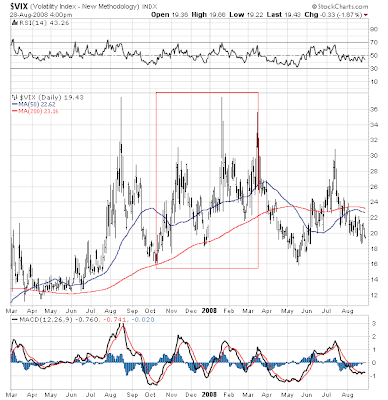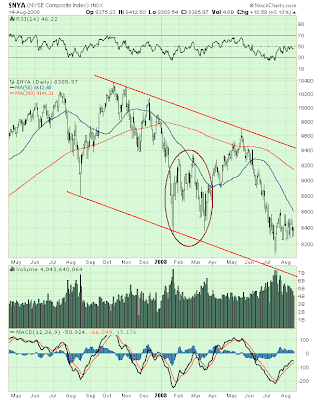There really is not much point micro-analyzing the vital signs of our sick, dying Monsieur Market. It is well enough right now just to get some truthful sense of his pathetic state...

Poor Monsieur Market. Looks like he might need ten Jim Cramer's, the privatization of Social Security, and, oh, another little old World War to grease the skids.
We really must sweep our Tory filth from the stage ... those monetarist monkeys — touch my monkey! pet it! love it! — and put the country and its business back to work again ... on a crash basis. Something like FDR ... JFK ... someone with courage enough to make all the bad debt go away ... along with those no good hens who laid so many rotten eggs.
And Senator Obama... $150 billion over ten years building windmills is chump change in Vegas, baby.
Metaphorically speaking, we'd be better off thinking like the "The Chairman of the Board" and demanding nothing less of our nation and its leaders...
Oh, but no. Wall Street's Mother demands unbridled love for such Masters of Disaster as can fill her media with mockery toward everything history teaches. With so much garbage being spewed, it's times like these American's ought really think about putting the EPA to good use.
Only the best slime for today's financial capitals of the world! And if it is a bad tree, can it bear good fruit?
We know how front page political frauds get where they are. Just follow the money. So, connect the dots. It's not hard imagining Wall Street (and probably The City, too) might soon become burnt toast. It's a safe bet because a bad tree bears bad fruit.
Well, they say be careful what you wish for. Most of the time this is just superstition. In this instance, however, it is looking like fait accompli. President Bush's "Mission Accomplished" takes on new meaning ... metaphorically speaking that is.
Actually, the risk of disaster coming from Mother's kitchen probably has more to do with the fact you cannot serve two masters. And this is what Franklin meant by "a Republic, if you can keep it" ... which necessarily requires a people who bear good fruit.

As you can see, this view of the underlying situation currently is not quite like December '07 or February '08. The subtle difference supports the notion the present period is a cyclically positive one. This, I assume, might lend some longevity to the market's buoyancy since July '08.
Really, though, how much better can things get? Truth is longevity might not afford great improvement.
Observe how much juice has been expended to produce such a pitiful bounce on the Big Board. This says something, too. Taken in combination with poor vital signs shown on the chart of the NYSE Composite ... it seems quite possible, then, a trip toward July's low might soon unfold.
Even were this to happen, though, there most likely will be life still left — a pulse remaining for one last attempt at a November fix ... coming from a bad tree's sick heart ... still beating with longevity.
This bears close watching because post-election events just might unravel like a metaphor in the search for the Holy Grail (particularly the club over the head part)...
* * * * *
© The Risk Averse Alert — Advocating a patient, disciplined approach to stock market investing. Overriding objective is limiting financial risk. Minimizing investment capital loss is a priority. Analysis centers on the stock market's path of least resistance. Long-term, this drives a simple strategy for safely investing a 401(k) for maximum profit. Intermediate-term, investing with stock index tracking-ETFs (both their long and short varieties) is advanced. Short-term, stock index options occasionally offer extraordinary profit opportunities when the stock market is moving along its projected path. Nothing is set in stone. Nor is the stock market's path of least resistance always known. More often than not, there are no stock index option positions recommended.  There's an easy way to boost your investment discipline... Get Real-Time Trade Notification!
There's an easy way to boost your investment discipline... Get Real-Time Trade Notification!















































